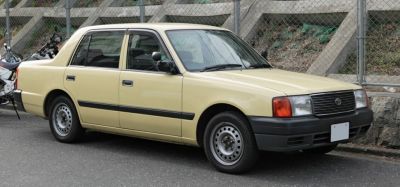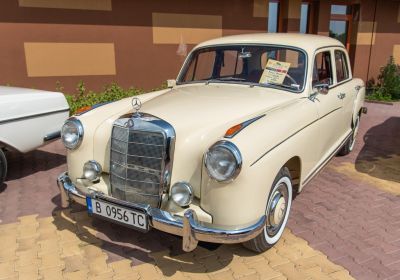 1958 Mercedes-Benz W128 Sedan Dimensions, Size & Specs
1958 Mercedes-Benz W128 Sedan Dimensions, Size & SpecsMeasurements of the 1958 Mercedes-Benz W128 Sedan, engineered for optimal performance and comfort
| Dimensions | |
|---|---|
| Length: | 4750 mm187.0 in15.6 ft |
| Width: | 1740 mm68.5 in5.7 ft |
| Height: | 1560 mm61.4 in5.1 ft |
| Weight Specifications | |
| Curb Weight: | 1345-1360 kg2965-2998 lbs |
| Maximal permitted Weight: | 1810 kg3990 lbs |
The Mercedes-Benz Ponton W128 Sedan, produced from 1958 to 1959, represents a notable chapter in Mercedes-Benz's post-war automotive history. Known for its classic styling and solid engineering, this vintage sedan boasts substantial dimensions that emphasize comfort and presence. Measuring 4750 mm (187 inches) in length, 1740 mm (68.5 inches) in width, and standing 1560 mm (61.4 inches) tall, the W128 Sedan offers a spacious interior typical of luxury sedans of the late 1950s. The curb weight ranges between 1345 and 1360 kg (2965 to 2998 lbs), reflecting the robust steel construction of the era, while the maximum permissible weight reaches up to 1810 kg (3992 lbs), allowing for ample passenger and cargo load. The Ponton series, with its distinctive rounded edges and clean lines, is often celebrated for blending functionality with an elegant aesthetic, making the W128 a desirable model among classic car enthusiasts today. Its size and weight contribute not only to a comfortable ride but also to stability and road presence, qualities that Mercedes-Benz has traditionally emphasized in its sedans. Overall, the W128 Sedan is a striking example of mid-20th century automotive design, balancing form and function in a package that remains respected in historical and collecting circles.
Discover the standout features that make the 1958 Mercedes-Benz W128 Sedan a leader in its class
Have a question? Please check our knowledgebase first.
The Mercedes-Benz Ponton W128 Sedan, produced between 1958 and 1959, has a length of 4750 mm (187 inches), a width of 1740 mm (68.5 inches), and a height of 1560 mm (61.4 inches). This size gives it an elegant and stately presence typical of luxury sedans from that era.
With a width of 1740 mm (68.5 inches), the W128 offers a relatively spacious cabin for its time, providing comfortable seating for four to five passengers. The width also contributes to stable handling and a comfortable ride, balancing road presence and maneuverability.
The curb weight of the W128 ranges between 1345 and 1360 kg (about 2965 to 2998 lbs), with a maximum authorized weight of 1810 kg (3992 lbs). This weight range ensures a solid feel on the road, contributing to its smooth ride and stable drive, but also requires a robust engine to deliver satisfying performance.
Standing at 1560 mm (61.4 inches) tall, the W128 has a generous height for a mid-20th century sedan. This height provides ample headroom for passengers, enhancing overall comfort, especially on longer journeys.
Yes, the Mercedes-Benz Ponton W128 Sedan fits comfortably into a standard garage. With its length of 4750 mm (187 inches or approximately 15.6 feet) and width of 1740 mm (68.5 inches or about 5.7 feet), it is compact enough for typical residential garages, which usually have lengths of about 6 meters (20 feet) and widths of about 2.4 meters (8 feet).
Compared to its predecessors in the Mercedes-Benz Ponton series, the W128 retained similar dimensions but offered subtle refinements. The length of 4750 mm (187 inches) remained within the mid-sized luxury sedan segment, while the width and height were optimized for improved interior comfort. This generation generally offered a more refined, modern styling and slightly improved cabin space without major size increases.
At 4750 mm (187 inches) long, the W128 was competitive in size with other luxury sedans of the late 1950s. This length placed it within the mid-to-large segment, offering a good balance of spaciousness and parking practicality. Many American sedans of the era were longer, while some European competitors were slightly shorter, so the W128 fit neatly into its luxury class.
The W128 typically seats five passengers comfortably. Thanks to its 1740 mm (68.5 inches) width and 1560 mm (61.4 inches) height, occupants benefit from good headroom and reasonable shoulder room for the period. Rear legroom is respectable due to the sedan's length, making it suitable for both city driving and longer excursions.
With a curb weight between 1345 and 1360 kg (2965 to 2998 lbs), the W128 balances solid construction and luxury features with reasonable fuel consumption for its time. The weight contributes to a smooth, stable ride and helps minimize road noise and vibrations, enhancing comfort. While not focused on fuel economy by modern standards, it was efficient compared to similarly equipped cars of the late 1950s.
Within its mid-to-large luxury sedan class, the W128 holds its own with its balanced dimensions: 4750 mm (187 inches) in length and 1740 mm (68.5 inches) in width. Compared to contemporaries like the Jaguar Mark 2 or BMW 502, the W128 offers competitive interior space and classic Mercedes-Benz engineering and comfort. It may be more compact than some American luxury models but focuses on refinement and ride quality over sheer size.
Discover similar sized cars.

| Production: | 1995-1999 |
|---|---|
| Model Year: | 1995 |
| Length: | 4695 mm184.8 in |
| Width: | 1695 mm66.7 in |
| Height: | 1515 mm59.6 in |

| Production: | 1956-1959 |
|---|---|
| Model Year: | 1956 |
| Length: | 4715-4750 mm185.6-187.0 in |
| Width: | 1740 mm68.5 in |
| Height: | 1560 mm61.4 in |
